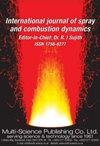煤油和天然气预混双燃料燃烧器火焰动力学的比较
IF 2.1
4区 工程技术
Q3 ENGINEERING, MECHANICAL
International Journal of Spray and Combustion Dynamics
Pub Date : 2022-03-01
DOI:10.1177/17568277221091405
引用次数: 2
摘要
在本研究中,研究了煤油和天然气运行中旋流稳定稀薄预混燃烧的火焰动力学。天然气旋流燃烧器采用双流体喷嘴进行改造,以使用相同的燃烧器硬件进行所有实验。混合物制备的复杂性从完全预混的天然气逐步增加到技术上预混的自然气,最后是技术上预混合的煤油燃烧。给出了三种构型的火焰传递函数,并进行了比较。这种方法允许通过实验分解FTF,并隔离当量比波动和液滴动力学的影响。此外,还提供了煤油操作中当量比和空气质量流量系统变化的FTF数据,并讨论了喷雾质量和对流延迟时间对FTF的影响。对于所有操作点,提供并评估静止火焰图像,作为FTF解释的基础。此外,还测量了NO排放量,以确定煤油操作中的预混合程度。通过系统的FTF比较,发现液滴对声强迫反应的频率范围可以从FTF相位读取。发现喷雾质量对FTF有显著影响,而对流延迟时间的变化不影响FTF。本文章由计算机程序翻译,如有差异,请以英文原文为准。
Comparison of the flame dynamics of a premixed dual fuel burner for kerosene and natural gas
In this study, the flame dynamics of swirl stabilized lean premixed combustion is investigated for kerosene and natural gas operation. A natural gas swirl burner is retrofitted with a twin-fluid nozzle to allow performing all experiments with the identical burner hardware. The mixture preparation complexity is stepwise increased from perfectly premixed natural gas to technically premixed natural gas and lastly technically premixed kerosene combustion. Flame transfer functions (FTFs) for the three configurations are presented and compared with each other. This approach allows to experimentally decompose the FTF and isolate the contributions of equivalence ratio fluctuations and droplet dynamics. Furthermore, FTF data for a systematic variation of equivalence ratio and air mass flow in kerosene operation is presented and the impact of spray quality and convective delay time on the FTF is discussed. For all operation points, stationary flame images are provided and evaluated as basis for the FTF interpretation. Additionally, NO emissions are measured in order to determine the degree of premixing in kerosene operation. Through a systematic FTF comparison, it was found that the frequency range in which droplets react to acoustic forcing can be read from the FTF phase. The spray quality was found to have a significant impact on the FTF whereas a change in the convective delay time does not affect the FTF.
求助全文
通过发布文献求助,成功后即可免费获取论文全文。
去求助
来源期刊

International Journal of Spray and Combustion Dynamics
THERMODYNAMICS-ENGINEERING, MECHANICAL
CiteScore
2.20
自引率
12.50%
发文量
21
审稿时长
>12 weeks
期刊介绍:
International Journal of Spray and Combustion Dynamics is a peer-reviewed open access journal on fundamental and applied research in combustion and spray dynamics. Fundamental topics include advances in understanding unsteady combustion, combustion instability and noise, flame-acoustic interaction and its active and passive control, duct acoustics...
 求助内容:
求助内容: 应助结果提醒方式:
应助结果提醒方式:


